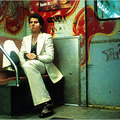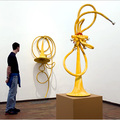
Chris Warde-Jones for The New York Times
Bulicame is one of the natural sulfur springs that dot the province of Viterbo, near Rome. They were discovered by the Romans in the fourth century B.C.
"IT'S an inferno in here,” yelled a middle-aged woman as she plunged into a foul-smelling hot spring in central Italy. She wasn't the first to compare these scorching sulfur baths to Hell. In Canto XIV of “Inferno,” Dante wanders past a pool oozing with boiling red water and is reminded of these thermal spas about an hour north of Rome “whose waters are shared with prostitutes.”
In truth, Bulicame is actually far from Hell. Situated on the outskirts of the Viterbo — a provincial capital where popes once took refuge — the Bulicame sulfur springs bob with pleasure seekers whose only sins may be self-indulgence and a proclivity for smelling like rotten egg.
The countryside around Viterbo is studded with Roman ruins and sprinkled with these so-called wild spas: natural springs that bubble up from the ground and spill into artificial basins in the middle of fields. In most cases, there are no entrance fees, no towel services and no changing rooms. The only things you need are a car and a little geography lesson.
Of the half-dozen wild spas in the region, the best known may be Bulicame, but it's not the most popular. Several are closely guarded secrets, which is why I was glad to be sitting across from Giovanni Faperdue in the Gran Caffè Schenardi in Viterbo (Corso Italia, 11; 39-0761-345-860; www.caffeschenardi.com), a gilded high-ceiling 19th-century cafe in the city's historic center. Mr. Faperdue, a journalist for the local newspaper and the author of six books on Viterbo's history (including one about the sulfur springs), is passionate about the city's mineral-water-rich landscape.
“In a sense, the springs like Bulicame are volcanoes of water,” he said, referring to the former volcanic craters that serve as the steamy water's source. “In ancient times, the spas in Rome were heated only by fire,” he added. “So when the Romans came to Viterbo in 310 B.C. to conquer the Etruscans, they took notice of the naturally hot springs.”
The Romans built huge complexes around the springs. Bulicame may be the easiest to find, just off the main road as you head toward the town of Tuscania. The four pools, of varying temperatures and sizes, are set into a gentle white knoll. Heaps of steam waft from a fenced-off hole atop a hill that channels 140-degree water to the pools.
Couples arrived carrying slippers, bathrobes and water bottles across a field. Perhaps it was my bare feet and boxer shorts that pegged me as a novice, but as I stood on the sidelines wondering which of the four pools I should dip into first, someone in the largest, swimming-pool-size bath offered a tip: “The smaller pools nearest the source are the warmest.”
I glanced at a bigger pool, where a man in skimpy bathing trunks was smearing greenish mud across his face and flipping water onto his enormous belly. I walked to a smaller pool, dangled my toe in the steaming hot water and plunged in.
After an hourlong soak — my skin smooth and soft, my mind at ease — I understood the addiction. The sulfurous water gushing from the ground around Viterbo is said to be therapeutic. The locals say it's particularly good for the skin, the respiratory system and aching bones. The Etruscans and Romans also believed in its curative properties. And after several popes in the Middle Ages were believed to have been cured of chronic back pain after a dip, Viterbo's baths became a near-obligatory stop for travelers on the Rome-to-Florence route.
Although the region's numerous sulfur springs draw from a single water source, each spa has its own personality and devotees. Another popular wild spa is Bagnaccio, which sits at the end of a long gravel road a few miles from Bulicame. This three-basin spa is known for its lively social scene, which, for the uninitiated, is a lot like crashing a private pool party. “You see the same people every day,” said one of the chatty regulars sitting in chest-high water. “It's like the coffee bar in the morning, but we happen to be sitting in smelly water.”
Le Pozze di San Sisto, about five miles south of Viterbo, may be the plushest, thanks to its civic-minded bathers. And Terme dei Papi is the most commercial, with its campuslike structures and spa product line.
The thermal baths around Viterbo weren't always so inviting. Until a few years ago, the pools were littered with trash. Taking advantage of the parasite-killing sulfurous water, farmers would bring their livestock for a dip, sometimes even lowering horses or sheep into the pool as people were bathing.
That began to change after Mr. Faperdue wrote a series of articles about the spas for the local newspaper. “It caused quite a scandal,” he said. Local residents, unaware of the state of the spas, were outraged. A volunteer force sprang up to police the springs.
At Bagnaccio, regular bathers now pay voluntary annual dues of 12 to 18 euros (about $16.60 to $25 at $1.38 to the euro) to keep the pools clean. Le Pozze di San Sisto went a step further: it became a members-only cultural association (annual dues of 15 euros, plus a 10-euro initiation fee). Unlike Bagnaccio, San Sisto checks for memberships at the door, which may explain why it may be the cleanest and most family-friendly of the wild spas.
“I liked the spa so much, I bought a house nearby just to be close to it,” said Mario Bracci, a resident of Rome who is the president of the San Sisto cultural association. “When the condition of the place was worsening, I decided to do something about it, so that's when we formed the association.” With 25,000 members, Le Pozze di San Sisto offers perks other area spas do not: a bar, changing rooms, picnic tables and seminars on yoga, crystal therapy and massage.
For spagoers seeking even more amenities, Terme dei Papi, or Baths of the Popes, a few miles west of Viterbo's historical center, offers up-market comforts in exchange for a more sterile atmosphere. Terme dei Papi now charges 10 euros to float in its sleek 100,000-square-foot pool. Much of the original medieval architecture has been replaced by charmless structures where Swedish massages and mud baths are administered by stern women in medical garb.
That may explain why spas like Bulicame seem to hold more appeal for the locals. In addition to being free, its commercial-free atmosphere and ancient Roman ruins infuse the bath with history. Besides, Dante's journey through “Inferno” and Bulicame eventually led him to “Paradiso.”
IF YOU GO
GETTING THERE
Viterbo is about 50 miles north of Rome. The two-hour train ride from Rome's Ostiense railway station departs hourly and costs 4.10 euros, or about $5.65 at $1.38 to the euro (www.trenitalia.com). By car, take the SS2 Cassia Bis straight to Viterbo, about one hour.
SPAS
Bulicame (corner of Strada Provinciale Tuscanese and Strada delle Terme): A 10-minute drive from Viterbo's historical center, it has four baths of varying degrees and a smattering of Roman ruins. Free.
Bagnaccio (from the S2 Cassia north, take the S7 toward Marta and turn left at Via del Garinei, a gravel road): A members-only bath, it has three pools that attract chatty and friendly regulars.
Le Pozze di San Sisto (Cassia south, toward Vetralla; 39-3286-893-884; www.lepozzedisansisto.org): About five miles south of Viterbo, its natural landscape and plush amenities brings spa lovers from all over the area.
Terme dei Papi (Strada Bagni 12, 39-0761-3501, www.termedeipapi.it): A mile or so from Viterbo, this famed spa is the most commercial of the bunch.
HOTELS
The Hotel Niccolo V at Terme dei Papi (Strada Bagni 12, 39-0761-350-555, www.termedeipapi.it) has 23 spacious rooms, some overlooking the thermal pool, starting at 120 euros.






